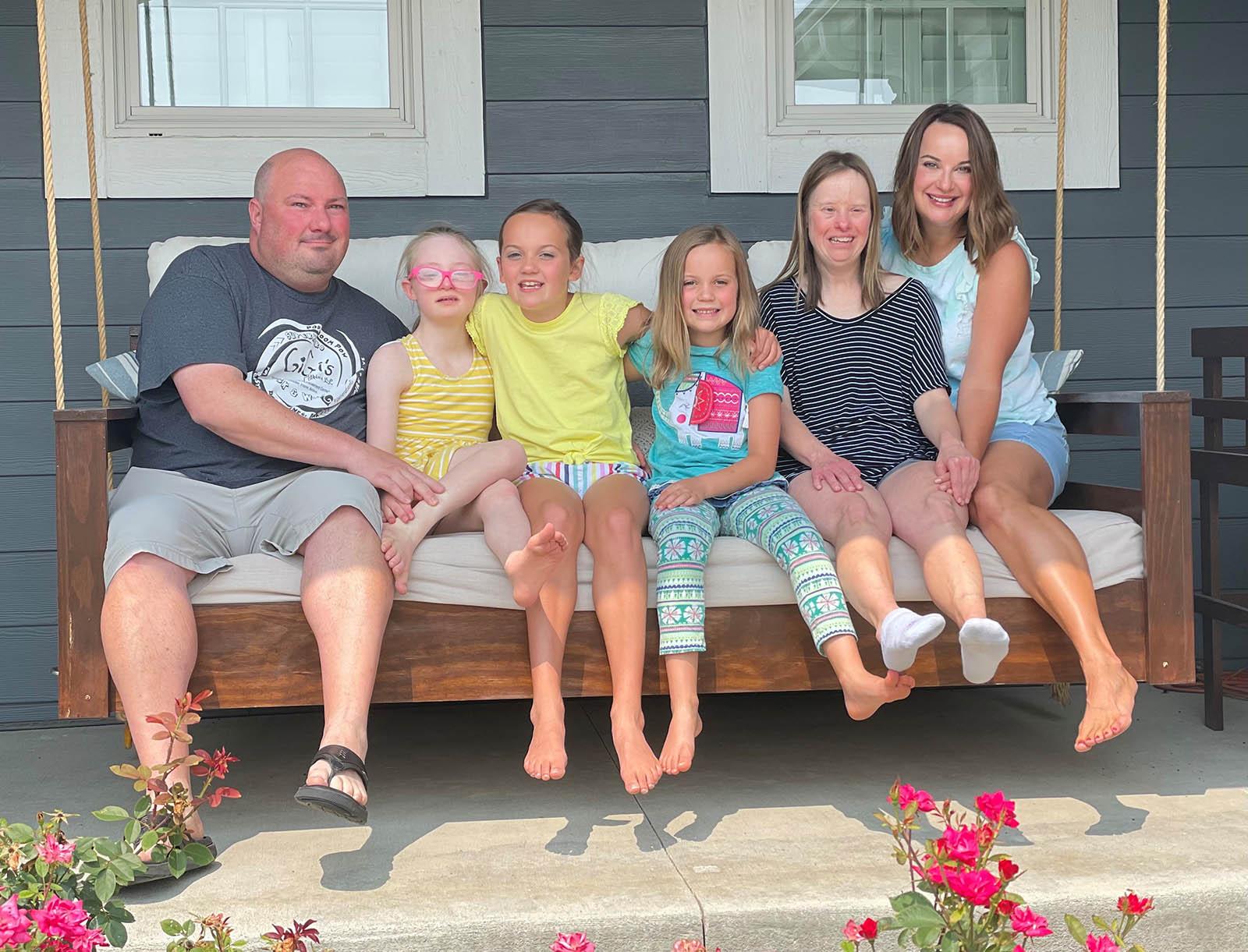
Approximately half of all infants born with Down syndrome have a heart condition (Delany et al., 2021). These conditions can have serious effects, and it is important that medical treatment is provided.
Some children with Down syndrome will show symptoms of their heart condition at birth, and some may even be diagnosed in utero. However, not all newborns will have obvious symptoms, so it is important to have an echocardiogram (a test that uses ultrasound to see if the muscle and valves of the heart are working) in the first two or three months of life.
The most common conditions are atrioventricular septal defect, ventricular septal defect, persistent ductus arteriosus, and tetralogy of Fallot.
Most Common Heart Defects in Children With Down Syndrome
Atrioventricular Septal Defect
An atrioventricular septal defect (AVSD) occurs when there are holes between the right and left sides of the heart, and the valves that control the blood flow between the two sides may not be formed correctly. AVSD is the most common congenital heart condition in children with Down syndrome.
In AVSD, blood is allowed to flow where it normally should not go. Blood can go from the lungs, where it gets oxygen, to the heart, then back to the lungs without taking the oxygen to the rest of the body. The extra blood flow to the lungs causes high pressure and forces the heart to work harder.
There are two types of AVSD: complete and incomplete. Complete AVSD occurs when there is a large hole in the center of the heart which allows blood to flow between all four quarters of the heart. In typically developing hearts, there are two separate valves in the center of the heart called the tricuspid valve and the mitral valve. In complete AVSD, these two valves fail to separate, and there is only one valve. The single valve often has flaps that do not close tightly, allowing blood to leak through.
Incomplete AVSD occurs when a heart has some but not all of the features of a complete AVSD. There is usually a smaller hole that doesn’t span across all four quarters of the heart. Both the tricuspid and mitral valves are formed, but one may not close completely allowing blood to leak through.
Ventricular Septal Defect
A ventricular septal defect occurs when there is a hole in the wall that separates the two lower quarters of the heart. In typical development, the right side of the heart pumps blood from the heart to the lungs to get oxygen, then the left side of the heart pumps the oxygenated blood to the rest of the body.
In a child with a ventricular septal defect, blood often flows from the left side of the heart through the hole to the right side of the heart and into the lungs. This extra blood going back to the lungs forces the heart and lungs to work harder to pump it to the rest of the body.
Sometimes, small ventricular septal defects will close on their own. If the hole is large or doesn’t close on its own, surgery may be needed.
Persistent Ductus Arteriosus
The “ductus arteriosus” is an opening between two major blood vessels in the heart. While a baby is in the womb, the ductus arteriosus diverts blood away from the lungs because prenatal blood already has oxygen from the mother. This opening usually closes shortly after birth. If it does not, it is called “persistent”.
If the persistent opening is very small, no treatment may be needed. If the opening is large enough, potential treatments include medications and surgery. An untreated persistent ductus arteriosus can cause conditions including high blood pressure in the lungs, heart infection, and eventual heart failure.
Tetralogy of Fallot
Tetralogy of Fallot is made up of four conditions occurring at once:
-
Ventricular septal defect (hole in the wall between the two lower quarters of the heart)
-
A narrowing of the passage from the right side of the heart to the lungs
-
The muscular wall of the lower right quarter of the heart is thicker than normal
-
An enlarged aorta, which carries blood from the left side of the heart to the rest of the body
Tetralogy of Fallot is considered a critical congenital heart condition because the child could need surgery soon after birth. Tetralogy of Fallot reduces the amount of oxygen in the body causing potentially serious problems. These include heart infection, irregular heartbeats, dizziness, fainting, seizures, and delayed growth.
About the Health Care Guidelines
The health care guidelines mentioned below help define the standards of quality care for individuals with Down syndrome. They include specific recommendations for screening tests, information about common medical conditions, suggestions for early intervention, diet and exercise and other issues across the lifespan.
Significance of Down Syndrome health care specific guidelines:
- For Parents: Specialized guidelines help define for parents what is needed, so they can communicate with their primary care physician and say, “This is what is recommended. This is what we need to do.”
- For Physicians : Defines the medical vulnerabilities and the necessary screenings for the Down syndrome population
Selecting the right health care professional:
- Find a professional who will collaborate with you, and someone who is open to listening to parents and seeing them as partners.
- One of the best ways to find a professional in your area is to ask families of other children with Down syndrome in the area.
- Search online parent support groups or find your local Down syndrome organization for support.
- Use the health care guidelines accessible to you and bring materials with you to the doctor!
Relationship of Heart Conditions to the Lungs
Underdeveloped lungs at birth happen more often in individuals with Down syndrome. This can limit the growth of blood vessels throughout the lungs. The smaller arteries cause higher pressure through the lungs. This pressure in the arteries that go from the heart to the lungs is called pulmonary arterial hypertension. Ongoing pulmonary arterial hypertension can cause thickening of the artery walls leading to hard, narrowed passageways for blood to flow through. When this happens, the heart must work harder to pump blood through the arteries. Heart failure is more common in people with pulmonary arterial hypertension.
Surgery
In many cases, heart surgery is used to correct congenital heart conditions. Often, doctors want to perform surgery within the first five to six months of the infant’s life to lessen the chance of lung damage. Although having Down syndrome raises the risk of surgery slightly above that of surgery on typically developing children, successful surgery will allow many children with heart conditions to thrive. There may be residual defects, but their effect on health is often minimal.
Hospitals that have experience in open-heart surgery on infants, especially experience operating on infants with Down syndrome, perform at least 10 of these operations a year, and that have a high survival rate would be considered an experienced hospital.
***
Citations
Delany, D.R., Gaydos, S.S., Romeo, D.A. et al. Down syndrome and congenital heart disease: perioperative planning and management. J Congenit Heart Dis 5, 7 (2021). https://doi.org/10.1186/s40949-021-00061-3
Patent ductus arteriosus. Mayo Clinic. https://www.mayoclinic.org/diseases-conditions/patent-ductus-arteriosus…. Published January 7, 2021. Accessed May 31, 2022.
Tetralogy of Fallot. Mayo Clinic. https://www.mayoclinic.org/diseases-conditions/tetralogy-of-fallot/symp…. Published August 17, 2021. Accessed May 31, 2022.
Additional Resources
External Resources
-
Conquering CHD
https://www.conqueringchd.org/
Education, support, research, and advocacy encompassing the lifespan, encouraging transparency, and meeting families where they are -
Adult Congenital Heart Disease Association
www.achaheart.org
Offers information on topics concerning congenital heart conditions -
American Heart Association
www.heart.org
Working to build healthier lives, free of cardiovascular diseases and stroke -
Little Hearts
www.littlehearts.org
866-435-4673
Provides support, education, resources, networking, and hope to families affected by congenital heart defects.







